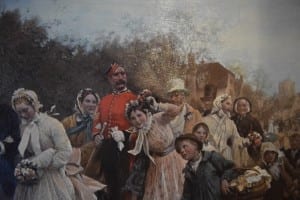Anthropology of the Brain: Consciousness, Culture, and Free Will (2014) suggests our minds extend beyond our bodies
Update
A May 23, 2017 Quanta article is entitled: “The Thoughts of a Spiderweb: Spiders appear to offload cognitive tasks to their webs, making them one of a number of species with a mind that isn’t fully confined within the head.”
[End]
Many years ago, Marshall McLuhan remarked in Understanding Media (1964) that electronic media are extensions of the human central nervous system.
Recently, I had the good fortune to come across an essay – entitled Anthropology of the Brain: Consciousness, Culture, and Free Will (2014) – that expands upon the above-noted concept.
I was keen to read about the anthropology of the brain after I read a book by City of Toronto Councillor John Filion, which has prompted me to read more widely about how the human mind works.
Some things we don’t know, about anything. “I don’t know” can, as has been remarked at an interview about death and dying on CBC Metro Morning on Nov. 12, 2015, be a great way to start a conversation. As with any interaction, such a conversation can lead to many insights.
Linguistic anthropology of schoolyard bullying
Among the topics I have revisited, after reading Filion’s book, is linguistic anthropology. Previous blog posts have referred to research by Marjorie Goodwin that analyzes schoolyard bullying from the perspective of this branch of anthropology. Two previous posts come to mind:
Aside from bullying, Marjorie H. Goodwin (2006) focuses on collaboration and political agency

Painting of a Wedding Procession at Old Mill Toronto, the site of a high school reunion that I was recently involved in organizing. I will be writing in future posts about what the painting signifies, and what comes to mind for me when I view it closely. Jaan Pill photo
Linguistic anthropology of Toronto
After I read the recent study by John Filion, concerning a former Toronto mayor, it occurred to me that Filion’s book provides sufficient detail, with regard to dialogue and body language, to imagine creating a series of storyboards, based on episodes in the book. The storyboards would be structured within the framework, based on tight scripting of scenes, of linguistic anthropology.
The book has also prompted me to start reading about the anthropology of the brain and about findings reported by neuroscientists regarding how the brain works.
I much enjoy it when a book, or some other thing that I encounter such as a painting in a hallway, or the sight of salmon running upstream in the fall, prompts me to investigate some topic further. I like the term that is sometimes used to describe such experiences. The term I like is: experiential learning.
I am so very pleased I read Filion’s book, as otherwise the concept of applying principles from Marjorie Goodwin’s work to a study of recent political life in Toronto would not have occurred to me.
John Filion’s book does not seek to apply anthropological concepts as a means of analyzing the book’s characters and incidents. Instead, he depends upon a Canadian psychotherapist, a frequent guest in media interviews, for an analysis of individual and family dynamics as they pertain to a former Toronto mayor.
From my perspective, social psychology does provide valuable insights, concerning topics addressed by Filion, but does not explain very much, in the wider scheme of things. That is, the wider context is of importance; individual psychology attends to a relatively small part of the picture, it appears to me.
Crazy Town (2014)
Another recent book that deals with a former Toronto mayor is Crazy Town (2014) by Robyn Doolittle.
Robyn Doolittle’s study is primarily focused on the facts, on the evidence, as they relate to the topics at hand. Although her study does not prompt me to consider how the text provides a starting point for further readings in anthropology, it does provide details that are of interest in the context of social interactionism, a framework for the study of social interactions, that I have also discussed in previous posts.
By way of example, Doolittle’s study focuses at length on the distinction between what Erving Goffman describes as backstage and frontstage behaviours, as they relate to a given definition of the situation.
I would say that, if you like to read key highlights about Toronto politics in recent years, Filion’s book is a good place to start. It offers plenty of evidence-based details, and also includes a wider setting of the scene, along with depictions of body language and mannerisms, all of which serve to bring the story to life.
After I had read Filion’s account, I found that Doolittle’s book was also worth a close read. Her study is presented from the perspective of a team of investigative reporters. The investigation by the team was intensive and, in the end, uncovered information that turned out to be of strong public interest.
It’s a book that would not, however, prompt me to want to do more reading about linguistic anthropology and the anthropology of the brain. I will, if time permits, return to the book and see what topics, other than the anthropology of the brain, that it might prompt me to explore.
Anthropology of the brain
The very concept of an anthropology of the brain is of interest to me, because it has occurred to me, as it has to many observers, that attempts to apply the findings of neuroscience research to aspects of everyday life sometimes make claims, about how the mind works and other topics, that are not warranted by the findings. For this reason, it’s of interest to learn about studies related to the rhetoric of neuroscience – for example, in popular media, as discussed in a previous post:
Brain Culture (2011): The metaphor of the brain as frontier

If you look closely, you will see a salmon trying to jump over the Humber River rapids at the Old Mill dam near Old Mill Toronto. The annual salmon run on the Humber River a most interesting phenomenon to observe. Click on the photo to enlarge it. Click again to enlarge it further. Jaan Pill photo
The latter post refers to a study entitled Brain Culture: Neuroscience and Popular Media (2011) by Davi Johnson Thornton, who focuses upon the rhetoric of neuroscience.
Neural circuits
Now, the concept that human behaviour, including social interactions, involve the play of interactive neural circuits involving large numbers of people, operating in the present moment and having a connection to events and people far back in time, has long been a topic of interest to me.
At times I’ve had an intuitive sense that such circuits are a part of life, and explain many things, that would otherwise not be so easy to comprehend. When I speak of intuition, I keep in mind that many things in life are counterintuitive. I do not assume that my intuition is of great value. But, the intuition is there.
Brainwashed (2013), Anthropology of the Brain (2014), and Nonsense (2015)
Reading Filion’s book prompted me to read Anthropology of the Brain: Consciousness, Culture, and Free Will (2014).
I’ve also decided to read Brainwashed: The Seductive Appeal of Mindless Neuroscience (2013) and Nonsense: The Power of Not Knowing (2015).
Consciousness and the Brain (2014)
I’ve also been reading Consciousness and the Brain: Deciphering How the Brain Codes Our Thoughts (2014).
For the current post, I will share blurbs for each of the books; in subsequent posts, when I get around to them, I will address Anthropology of the Brain in some detail, as it is a book that is of much interest to me. The following blurbs are from the Toronto Public Library website.
Anthropology of the Brain (2014)
In this unique exploration of the mysteries of the human brain, Roger Bartra shows that consciousness is a phenomenon that occurs not only in the mind but also in an external network, a symbolic system. He argues that the symbolic systems created by humans in art, language, in cooking or in dress, are the key to understanding human consciousness.
[End of text]
Brainwashed (2013)
In recent years, the advent of MRI technology seems to have unlocked the secrets of the human mind, revealing the sources of our deepest desires, intentions, and fears. In this book, the authors argue that the explanatory power of brain scans in particular and neuroscience more generally has been vastly overestimated. Although acknowledging its tremendous potential, they believe that the overzealous application of the burgeoning field of brain science has put innocent people in jail, prevented addicts from healing themselves, and undermined notions of free will and responsibility.
[End of text]
Consciousness and the Brain (2014)
A breathtaking look at the new science that can track consciousness deep in the brain. How does our brain generate a conscious thought? And why does so much of our knowledge remain unconscious? Thanks to clever psychological and brain-imaging experiments, scientists are closer to cracking this mystery than ever before. In this lively book, Stanislas Dehaene describes the pioneering work his lab and the labs of other cognitive neuroscientists worldwide have accomplished in defining, testing, and explaining the brain events behind a conscious state. We can now pin down the neurons that fire when a person reports becoming aware of a piece of information and understand the crucial role unconscious computations play in how we make decisions. The emerging theory enables a test of consciousness in animals, babies, and those with severe brain injuries. A joyous exploration of the mind and its thrilling complexities, Consciousness and the Brain will excite anyone interested in cutting-edge science and technology and the vast philosophical, personal, and ethical implications of finally quantifying consciousness.
[End of text]
Nonsense: The Power of Not Knowing (2015)
An illuminating look at the surprising upside of ambiguity – and how, properly harnessed, it can inspire learning, creativity, even empathy. Life today feels more overwhelming and chaotic than ever. We face constant political and economic upheaval, and we’re bombarded with information, much of it contradictory. Managing uncertainty – in our jobs, our relationships, and our everyday lives – is fast becoming an essential skill. What should we do when we have no idea what to do? In Nonsense, Jamie Holmes shows how we react to ambiguous situations and how we can do it better. Being confused is unpleasant, so we tend to shutter our minds as we grasp for meaning and stability, especially in stressful circumstances. We’re hard-wired to resolve contradictions quickly and extinguish anomalies. But in doing so, we lose a vital opportunity to learn something new, solve a hard problem, or see the world from another perspective. Over the last few years, new insights from social psychology and cognitive science have deepened our understanding of the role of ambiguity in our lives and Holmes brings this research together for the first time, showing how we can use uncertainty to our advantage. Whether we’re dealing with an unclear medical diagnosis or launching a risky new product, Nonsense promises to transform the way we conduct business, educate our children, and make decisions. In an increasingly unpredictable, complex world, it turns out that what matters most isn’t IQ, willpower, or confidence in what we know. It’s how we deal with what we don’t understand.
[End of text]




Leave a Reply
Want to join the discussion?Feel free to contribute!